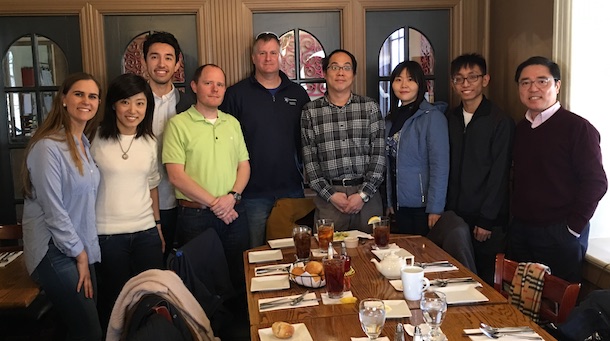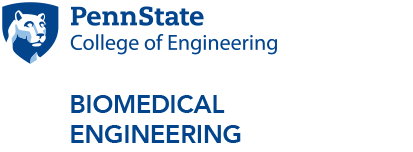
Hong Kong Polytechnic University visitors join Penn State biomedical engineering faculty and staff for lunch at the Nittany Lion Inn.
Learning on the other side of the world, part 2
Hong Kong Polytechnic University students visit Penn State as part of global capstone project
4/15/2019
Note: This is the second in a two-part series about the Department of Biomedical Engineering’s global capstone project with the Hong Kong Polytechnic University. Part one was about the Penn State students’ experience in Hong Kong in November 2018, while part two is about the Hong Kong Polytechnic University students’ experience visiting Penn State in January 2019.
In early January, the Penn State Department of Biomedical Engineering hosted two Hong Kong Polytechnic University (PolyU) biomedical engineering students, Chi Hin “Gordon” Hung and Tanyaporn “Beam” Panyang, as part of the department’s global capstone project.
During part of the 2018 Thanksgiving break, Penn State biomedical engineering students Kevin Godzik and Julia Minakowski visited Hung and Panyang at PolyU. The four students are collaborating on a global capstone project titled “Development of a Novel Hairy Hydroxyapatite Strengthened Hydrogel Membrane as Artificial Periosteum.” The work focuses on creation of materials to promote angiogenesis, the development of new blood vessels, and osteogenesis, the formation of bone. At Penn State, the capstone project is run by Dan Hayes, associate professor of biomedical engineering, and at PolyU, it is run by Xin Zhao, assistant professor of biomedical engineering.
The capstone project is unique because of the differences in how Penn State and PolyU generally structure their capstone projects. At Penn State, a capstone project is a single semester, and at PolyU, a capstone project takes up the entire academic year. So, to work with PolyU, Penn State’s Department of Biomedical Engineering structured a full-year global capstone project where the two Penn State students take BME 496 Independent Studies in the fall and then take BME 450 Biomedical Senior Design in the spring.
“Basically, we are doing the biological characterization while they are doing the mechanical characterization,” Panyang said. “We're also sharing our research experiences and the results, plus discussing how the project will be done.”
Discovering how research is done in America
The academic activities for the four students in University Park mirrored the activities in Hong Kong. At PolyU, the four students worked together on producing a material that can be used for inducing differentiation of stem cells into other cells, a key step for angiogenesis and osteogenesis. This material was brought back to Penn State to conduct mechanical testing while Panyang and Hung were visiting.
Along with testing the material, they learned how research is conducted at an American university by visiting and talking with Penn State researchers.
“We did a lab tour, and we had an opportunity to see what sort of lab devices they have here at Penn State,” Panyang said.
The Hong Kong students discovered that size is one major difference between PolyU and Penn State labs. PolyU has vertically oriented labs, making it difficult to have open concept labs, and their facilities are separated in individual rooms. The Penn State labs that they visited in the Millennium Science Complex have more of an open concept.
Panyang and Hung also saw that their equipment at PolyU is very spread out compared to Penn State. For example, at PolyU there is one cell culture room for all labs, whereas Penn State’s labs each have their own cell culture hoods. However, both the Penn State and PolyU students noted that each university’s labs shared the same dedication to proper protocol.
Along with discovering how research is done in America, Panyang and Hung also viewed the trip as an opportunity to scout out a potential graduate school. “It’s good to know what other universities are like,” Hung said. “We are final year students about to finish our undergraduate studies and we are learning if the university here is good for our future studies.”
Different universities, different worlds
Similar to differences that Godzik and Minakowski found at PolyU compared to Penn State, Hung and Panyang found the university experience at Penn State to be different than their own. “As a Hong Kong person from a super crowded city, it's very interesting and new for me to come to the U.S. to see an environment where everything is so big,” Hung said. “Our school is so crowded that the biomedical engineering department needs to share our building and classrooms with every department at PolyU. Here, biomedical engineering has their own building, and it’s a special thing for me to see.”
Along with visiting Penn State labs and other facilities, part of the trip was getting to see the sights and experience Happy Valley, which proved to be a completely different world than Hong Kong for Panyang and Hung. Things that many Penn State people take for granted were quite new for them.
“The campus here has a lot of animals,” Panyang said. “For us, we have a campus in the city and we don't see much in way of trees, animals, etc. We found it very peaceful as well. That will be something to tell my friends, how it’s so different here.”
Part of the sight-seeing included a visit to Berkey Creamery, and a trip to Tussey Mountain for snowtubing. However, at that time Tussey was snow-free, so instead of snowtubing, they spent time taking in the vista overlooking Happy Valley.
“It is so beautiful here,” Panyang said. “I’ll always remember that.”
During their travels, Hung and Panyang noticed certain aspects of America that are different from Hong Kong and that many Americans may find surprising. One example they gave was seeing people having their photos taken at the Nittany Lion Shrine. To them, it was surprising to see people leaning on a statue. “In Hong Kong, if there is a statue people can't touch it because they worry people will break it,” Hung said. “But here you can.”
While there were plenty of memories made during both trips, all four students agreed that the opportunity for collaborative work with colleagues at another university on a global scale was perhaps the biggest benefit of the project.
“It's not just the experience here at Penn State but the whole project because we had a chance to work together,” Panyang said. “For example they got to arrange our visit and we got to arrange their visit and share our home university with each other. And it's more than just studies, we got to know more about each other and share our ideas and experiences.”



